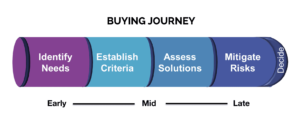How to Navigate the Buying Journey

In today’s sales arena, buyers have more power than ever. The internet has opened up more options and research to buyers than they’ve ever had. This presents a unique and exciting challenge for sales forces. How do we make sales when we do not have the leverage we’ve traditionally had throughout the sales process?
Traditionally, salespeople were the gatekeepers for information that buyers needed. They were able to introduce new products and solutions to buyers and being the first to initiate and share information was a big part of the process. It allowed salespeople to play the role of innovator and leader throughout the sales process. It also allowed them to shape deals in ways that were more favorable for their organizations. Now buyers have information for not just your product, but all your competitors’ products, at their fingertips. They can look up reviews, discuss products in forums, watch demos, and more, all before they encounter a salesperson.
Fortunately, our research into Sales Agility, or the ability of salespeople, managers, and organizations to align their practices and coaching with desired results, has shown a path forward for sales teams in this brave new sales world. If you can flex your behavior instead of staying rigidly married to one selling strategy or methodology, you can achieve success.
In this blog we’ll discuss what the buying journey is, how to meet the buyer where they are along the buying journey, and strategies that will give you back the agency you need to close the sale.
What is the Buying Journey?
The buying journey is the name we give to the process by which organizations and decision-makers within them come to the decision to buy a certain product. Understanding the buying journey and how the buyer(s) navigates that journey is a foundational skill that is required for sellers to understand and make sense of individual buying situations.
The four stages of the buying journey are as follows:
- Identify Needs
- Establish Criteria
- Assess Solutions
- Mitigate Risks
Along each stage, buyer psychology will shift, and salespeople need to be able to adapt to these shifts. Buyers’ needs vary by stage as well, so serving these needs is the key to your success. Let’s look at each stage in more detail and discuss ways to win at each one and help the buyer progress through to the end.
1. Identify Needs
In the identify needs stage of the buying journey, buyers are just starting to realize that they may have a problem that needs solving. They may want to improve some aspect of their business but aren’t sure how. So, buyers in this stage are working to figure out or define their exact problem so they can have a better target to aim at when searching for solutions.
In this stage salespeople have a huge chance to shape the deal in their favor. Even with the shift towards buyer agency that we discussed at the beginning of this blog, many buyers will still outsource a lot of this thinking and work to salespeople. So resourceful salespeople will be able to help buyers clearly understand their problems and what solutions will work best. By revealing these problems, you can drive urgency, and that urgency will propel the buyer to the next stage.
While some buyers still do enlist salespeople to help them in this stage, many buyers will already have bypassed this stage by the time they make first contact with a salesperson. So, it is vital that when you first engage with a prospective buyer, you determine if they are still in this stage. A simple interview should clarify this and allow you to orient yourself to their positioning.
2. Establish Criteria
In this stage, buyers have figured out what their problem is, and now they are determining what they need to do to solve it. As we’ve repeated already, buyers are coming to us already partway through their journey, so the first thing you’ll need to do is assess if they are still in this phase. If they’ve already established their criteria, you need to shift your focus to the next phase.
Once again, if you can engage with a buyer at this stage, you have a much better chance of developing authority and agency in the sales process. By helping the buyer figure out what exactly they need to do to solve their problem, you can position yourself as the expert among your competitors, and your solution as the most well-tailored option. You can influence buyers at this stage to understand how a higher ticket item will actually be more beneficial and meet more of their criteria, thus increasing your revenue per sale.
However, it’s important to keep in mind buyer psychology at this stage. They will have more access to competitor information than they would have in the past, and so they will do their due diligence using the criteria you’ve helped them define. Now, while this might sound disadvantageous, it follows a mental model called the first-mover advantage. First-mover advantage is defined by HBR as “a firm’s ability to be better off than its competitors as a result of being first to market in a new product category.” If we apply this to sales, firms who first help customers establish their criteria have established an authority that competitors will have trouble overcoming.
3. Assess Solutions
Now we are moving into the mid to late stages of the buying journey. Here is the point where many modern clients will first interact with sellers. If you’ve been lucky enough to meet with and help clients move through the first two stages, you’ll feel very good about your chances from here on out as you’ve had a hand in shaping their expectations all throughout their journey. But if this is your first interaction with them, you’ll quickly need to come up to speed and meet them where they are.
During this stage, buyers are reviewing their options. They have a list of possible solutions and are comparing solutions on that list against one another. It is imperative here that you make your product stand out against your competitors. You can ensure this by studying up on the competition and ensuring that sales managers are thoroughly vetting and coaching to the presentations that will be given to buyers.
Sometimes buyer processes are not aligned with their best outcome, and therefore it is the seller’s job to help them adjust their processes. This is tricky. Buyers at this stage will be resistant to change, especially when it goes against their preconceived beliefs. But if done successfully it can help present your solution in the best light, and help you develop a stronger relationship with the buyer.
4. Mitigate Risks
At this stage, buyers are close to making a commitment, but paradoxically, they may withdraw at this stage because they worry about making the wrong decision. It is your job to inspire confidence in that decision. Empathy is the keyword at this stage. You need to understand your buyer’s fear and worries and do your best to alleviate them. You need to continually offer assurance and proof that your solution is the best.
As we said, buyers may withdraw and reduce the amount of contact they have with salespeople. Understanding this, salespeople should resist the urge to chase and increase the volume of their communication to an annoying level. As with any relationship, coming off too needy or desperate can be a turn off. And remember, deals are largely shaped by this point, so keep a steady stream of communication and make sure you’re providing sufficient references, case studies, and other proofs to make your buyer feel comfortable.
Decision
Every buyer’s journey ends in one place, the decision. Hopefully that decision is to buy your product or solution, and we hope this overview of the buying journey and buyer psychology has given you some tips to make that happen.
Remember, Sales Agility means assessing and adjusting to the situations and opportunities in front of you. So why not start with your current pipeline? What stage of the buying journey are the opportunities in your pipeline in, and how can you change your behaviors and coaching to better lead them through it?
For a more in depth look at Sales Agility, check out our blog series here.
Our Offerings
The Pipeline Coaching Code™ equips sales managers and leaders with a powerful framework for assessing the health of the pipeline, considering size, contents, and progress. It then equips managers to make deliberate decisions about how to ensure the health of the pipeline and the viability of deals within the pipeline. Managers will reorient effort toward the early stages of deals to improve deal viability and velocity.
The Sales Management Code™ equips sales managers with a simple, yet powerful framework for aligning seller and manager efforts to desired business results, coaching in ways that drive maximum impact, and assessing leading indicators of progress to determine if sellers are on the right path to quota.
VantagePoint Performance is now part of Imparta, a global leader in performance improvement for customer-facing teams.
